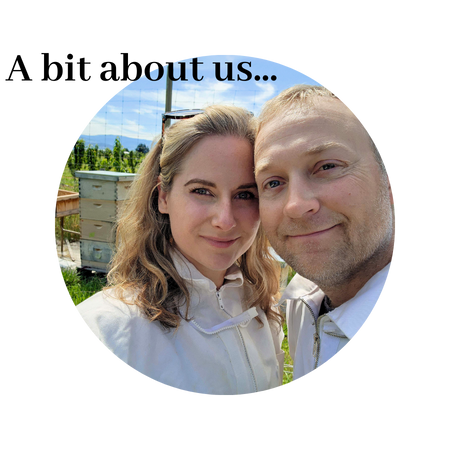One thing a beekeeper needs to know how to do well, is mark a Queen bee. There are many different ways a beekeeper can do this, but it all comes down to knowing the proper color for that year, having the best marking tools that are non-toxic and still highly pigmented, and then getting that colorful dot on the back of your Queen gently. Sounds easy enough, right?
Well, we are here to share some of our best tips for marking your Queens. We will talk about how to determine the proper colored dot for the year your Queen hatched in, and then we have a lot to say about the proper markers to have as part of your beekeeping supplies!
We will also share how we personally mark our Queens and show you a YouTube video of us marking our newest Queens this year.
Why do beekeepers mark Queens?
Marking a Queen bee is a very important task for the beekeeper and is a well-known practice in the beekeeping community.
Once there is a Queen bee present (whether she was hatched or your purchased a new Queen for your hive), she should be marked with the proper color.
Here's why:
- Queen identification: Marking the Queen bee helps beekeepers easily identify her within the hive during a hive inspection. This helps to make sure that there is still a Queen inside. Spotting her is essential for monitoring her health, behavior, and reproductive status
- Hive management: Marking the Queen allows beekeepers to track her movements, ensuring she is present and active in the hive, which indicates a healthy colony (if there is no Queen , you could lose your hive, so this is extremely important!)
- Swarm prevention: Marking a Queen will help you identify if your hive has swarmed or not. If you had a marked queen and during your inspection you find she is not longer marked, its probably a new queen.
- Age tracking: Marking enables beekeepers to track the age of the Queen, which is valuable information for managing the hive and planning the Queens replacement if necessary (in which case, a beekeeper would have to find a reputable Queen bee seller and put an order in, which could take months to get). Sometimes the original Queen is too old to produce enough eggs, which is another indicator of an emerging Queen replacement
It is clear that marking a Queen bee is one of the important steps in beekeeping.
So as part of your beekeeping supplies, you should have a Queen marking pen or Queen marking kit with a high quality marker, and possibly a good one handed Queen catcher to make sure your Queen stays still during the process.
This last tool isn't actually necessary, but we will talk about all of these points below and why you may or may not want to consider using them.
Let's get into it.

Marking Queen Bees
Before we get into the actual marking of your Queen bee, let's first talk about the proper colors to use.
The colors of your markers will be associated with a number, and this number is the last digit of the year.
Queen Marking Colors
Here are the Queen marking colors associated with the last digit of the year:
- Years ending in 0 or 5: blue
- Years ending in 1 or 6: white
- Years ending in 2 or 7: yellow
- Years ending in 3 or 8: red
- Years ending in 4 or 9: green
It is as simple as that, and it is a perfect way of visual record keeping.
And the way it works, is if the Queen hatches during that year, that is the color you mark her with, whether you mark her that year or in the following spring.
The color refers to the year the Queen hatched in.
Queen Bee Marking Pens or Markers
When it comes time for Queen marking, there are a few different pen or marker choices for you to mark your Queen.
We personally use and trust Uni-Posca markers with a specific nib size for marking Queens, but there are a other choices you could try as well.
Here they are:
1. Uni Posca Markers
See the ones with the correct nib tips here
Posca markers have long been the favorite marking pens for beekeeping for many, many years.
We first purchased Posca markers for Queen marking from a bee supply store a few decades ago! Most beekeepers use these markers and trust them to do a perfect, easy job.
Here is a photo of ours this spring:
Bee Safety
First, let's talk about the safety of the ink for bees. These Posca markers are water-based acrylic paint markers, generally considered to have low toxicity and be safe for various applications.
Regarding the application process, Posca markers are known for their versatility and smooth application on different surfaces, which is another reason why they work so well for bees.
These markers allow for precise marking, which could potentially be suitable for marking the bee's thorax. It is just important to grab the right Posca markers so the tip is large enough (but not too large) and is soft, allowing it to pick up a large pigment load so you only have to gently touch the Queens thorax of the bee once so there is no harm or distress to the bees during the process.
See the correct Posca nib tip for Queen marking here
Pigment
In terms of pigmentation, Posca Markers offer vibrant, highly pigmented colors. This high pigmentation can make it easier to spot a marked queen bee among other bees on a frame, and also allows you to not have to press very hard on your Queen as you dot her.
Posca is a reputable brand that has been around for many years, known for producing high-quality markers suitable for various artistic and creative purposes. They last for a very long time as long as you store them sideways so the nib stays saturated with ink.
This is a buy once and use for the next several years kind of product, which is why we recommend getting a pack with all of the colors needed for Queen marking.
2. Arteza Markers
See the correct size right here
These pens are specifically designed for artistic purposes but can also be used for marking Queen bees as well!
The water-based acrylic paint is non-toxic and safe for use on the thorax of bees. The pens offer precise application with the larger tip, allowing beekeepers to mark Queen bees easily and accurately, without harming them at all.
The vibrant colors of the marking pens make it super easy to spot a marked Queen bee on a frame full of worker bees, helping in your hive management and identification.
Arteza is a trusted brand known for producing high-quality art supplies, ensuring the reliability and performance of the markers for beekeepers.
We have personally worked with Arteza paint pens for their projects (they are super versatile and work well on paper, plastic, canvas, rocks, wood, glass and other mediums), but have not used them for bee marking as of yet. There are beekeepers out there who do use the Arteza's as a Queen marking tool with success.
That is really it for our marker recommendations for marking bees! It would be easy to list several different brands, but we want to stick with products we have used or know that other beekeepers use with great success.
Again, we have been using our same Posca markers for so long that we haven't had the chance to try out any others.
Here are some things to know about marking a healthy Queen.
Marking Queens
How to prime your paint pens
When you are about to use a painting pen for the first time to mark a Queen, you will have to unwrap the marker and then you will notice that the nib is white with no ink on it. You will need to prime your paint pen.
- Shake your paint pen. You should hear the small balls inside as you shake; this will ensure that the ink is fully mixed and is ready for use
- Push the marker nib down onto a piece of paper or cardboard. This allows the marker nib to retract into the marking tube to pick up the ink and saturate the nib
- Keep retracting the nib into the tube by pressing it down over and over again until you see the ink fully saturate the nib
- Try out the marker on your paper or cardboard. You should see the flow of ink coming from the tip now
- Your marker is now primed and is ready for your unmarked Queen to get a bit of color!

How to mark a Queen bee
There are a few schools of thought when it comes to marking a Queen. You can:
-
Mark her on the frame: Pull your frames until you see the Queen, and then gently mark her as she is walking around on the frame (make sure your marker is loaded and saturated so you don't have to press into her and disturb her)
or
-
Pick her up and mark her: Find your Queen honey bee on the frame, and gently pick her up between your thumb and index finger. Then gently mark her.
It is a personal choice when it comes to the method of how you will mark your Queen bees. Some beekeepers prefer to use a Queen catcher, as it will somewhat stabilize her mobility and then you can get a good, clean dot of color on her thorax.
We personally prefer the first method of finding Queens and simply marking them as they are working on laying eggs around the brood frame.
Here we are marking a Queen as she is laying eggs:
If you have a good quality marker that is saturated with high pigment ink, you won't have to press hard or disturb her at all while you are doing it this way. Just gently push your marker onto the top center of her back, which is her thorax.
You will find that barely any pressure at all is perfect for placing the ink on her. And no need to rub the marker around, if your marker tip is saturated enough, simply touching her should do the trick.
Again, marking technique is a matter of personal preference and comfort level.
Here is a YouTube video of us marking an unmarked Queen just this past spring in our backyard. It is a short video, but you will see exactly how we mark her without a Queen marking cage.
We simply locate her on the frame, have the marker ready and primed and give her a quick dot on the back, according to the year she was born in (in this case, it was yellow because she was born in 2022).
Watch it below: (and please subscribe, we'd appreciate the support!)
If you are interested and feel more comfortable putting your Queen bee in a Queen marking cage, by all means do what is best for you! New beekeepers may feel more confident doing it this way, while wearing gloves.
We have some suggestions for a Queen marking cage (or some like to call a Queen marking tube) that you can purchase for a Queen bee.
See the Queen marking cage here
Once you have a marked Queen (by hand or with a marker cage), is there anything else you should do? Nope! Once that little colorful dot of non toxic ink has been place on your now marked Queen, you just simply put the frame back in the hive and feel good knowing the job is complete!
Experienced beekeepers know that a marked Queen honey bee makes a healthier hive, as you can now inspect it properly and make sure she is present and laying a good pattern of eggs.
Will the other honey bees (drones, worker bees) notice once you have a marked Queen? No. The bees will not try to clean the marking off of their Queen honey bee.
Experienced beekeepers will tell you that marking a Queen bee goes generally unnoticed by the honey bee colony. Other bees like the hard working worker bees just continue focusing on their job in the hive! That dot is on her for good, and nobody in the hive will notice the marked Queens, rest assured).
In conclusion...
In conclusion, Queen marking is a task that is extremely important to do for the healthy of your honey bee colony, as it will allow you to identify her during inspections and give you a lot of information about her health and laying pattern (and whether she is still present!).
A marked Queen makes a healthy hive, and it won't affect the other bees or a Queen's mating flights or any other aspect of daily hive life.
To mark a Queen, use a high quality, highly pigmented marker with the proper tip, and either mark her on a frame or use a Queen catcher or a Queen marking tube. New beekeepers take note: water based art pens are your best bet for this.
It is easy to mark a Queen with the right tools for your comfort and experience level. And you can bookmark this page to make sure you are using the proper color for marking the Queen for the year she hatched in, and not to use too much pressure.
You can practice marking bees on yourself - with your left hand or right hand or even just your index finger before actually doing it if it makes you feel comfortable!
The proper pressure will mean that you can apply a dot of ink on yourself and barely feel it at all. Most bees won't notice if you are gentle and slowly push with the absolute minimal amount of pressure.
Here are some other articles you may be interested in reading:
Everything Needed To Start BEEKEEPING
How To Make Beeswax Wraps | INSTRUCTIONS
Did you like this article?
❤️ Here's how you can support our blog:
My name is Linnea and I am a backyard gardening enthusiast! Along with my husband and our two kids (and chickens, ducks and our little dog Izzy). Our hobby - growing our own food and making our meals from scratch. My blog, The Farmers Cupboard, is the website that blossomed from that passion. I love every second I spend sharing our hobby with like minded backyard growers.
It's easy to support my blog, and it is so appreciated. Please SHARE an article somewhere, pin a photo to your Pinterest board, follow on any of our social medias or sign up for our newsletter! That's it!
These little things help our blog grow and allow us to continue doing what we love: growing good food and sharing what we learn.
PINTEREST PASSIONATE? We're opening up our cupboard to you!
Click on the pin below made just for you. It will bring you right to my little Pinterest community, where I would love for you to FOLLOW The Farmers Cupboard and see all of our gardening and backyard dream ideas!

Let's grow good things together!









0 comments